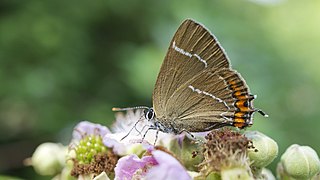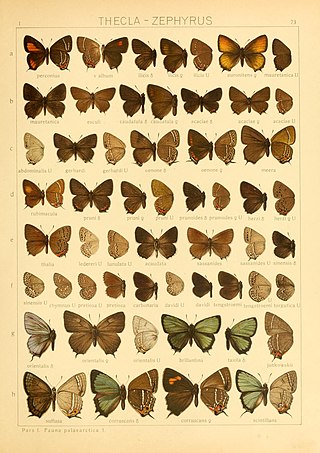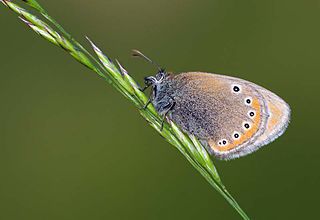
The white-letter hairstreak is a butterfly in the family Lycaenidae.

The black hairstreak is a butterfly in the family Lycaenidae.

Satyrium esculi, the false ilex hairstreak, is a butterfly in the family Lycaenidae. The species was first described by Jacob Hübner in 1804.

Satyrium acaciae, the sloe hairstreak, is a butterfly in the family Lycaenidae.

Satyrium ledereri, the orange banded hairstreak, is a butterfly in the family Lycaenidae.

Parnassius tenedius, the tenedius Apollo, is an east Palearctic member of the snow Apollo genus (Parnassius) of the swallowtail family (Papilionidae). Populations range from Siberia and the Far East of Russia to the western Chukchi Peninsula, Mongolia and north China. The larva feeds on Corydalis species. In the northern part of its range it is a low altitude butterfly; further south it is montane.

Allancastria cerisyi, the eastern festoon, is an Old World papilionid butterfly whose geographical range extends from the Balkans to include Turkey and the near Middle East. It exhibits several geographical variants.

Coenonympha arcania, the pearly heath, is a butterfly species belonging to the family Nymphalidae.

Coenonympha glycerion, the chestnut heath, is a butterfly species belonging to the family Nymphalidae. It can be found in Eastern Europe and east across the Palearctic to Siberia and the Caucasus to North Korea.

Melitaea didyma, the spotted fritillary or red-band fritillary, is a Palearctic butterfly of the family Nymphalidae.

Agriades optilete, the cranberry blue, is a butterfly of the family Lycaenidae. It is found in north eastern Europe, the Alps, North Asia, Japan, Korea and north western North America.

Tomares ballus, the Provence hairstreak or cardenillo, is a butterfly of the family Lycaenidae. It is found on the Iberian Peninsula, northern Africa and along the Mediterranean coast of France.

Polyommatus daphnis, the Meleager's blue, is a butterfly of the family Lycaenidae.

Satyrium prunoides is a butterfly of the family Lycaenidae. It was described by Otto Staudinger in 1887. It is found in the Russian Far East, Mongolia, north-eastern China and Korea.

Satyrium herzi is a butterfly of the subfamily Lycaeninae. It was described by Johann Heinrich Fixsen in 1887. It is found in the Russian Far East, north-eastern China and Korea.

Coenonympha leander, the Russian heath, is a butterfly belonging to the family Nymphalidae. It is found in northern Greece, Hungary, Bulgaria, southern Russia, Asia Minor, Armenia and Iran. The habitat consists of warm grassy areas.

Araragi enthea is a small butterfly found in the East Palearctic that belongs to the lycaenids or blues family.

Rapala arata is a small butterfly found in the East Palearctic that belongs to the lycaenids or blues family.

Satyrium eximius is a butterfly found in the East Palearctic that belongs to the blues family.

Cyaniris bellis, the Greek mazarine blue, is a butterfly found in the Palearctic that belongs to the blues family.

















